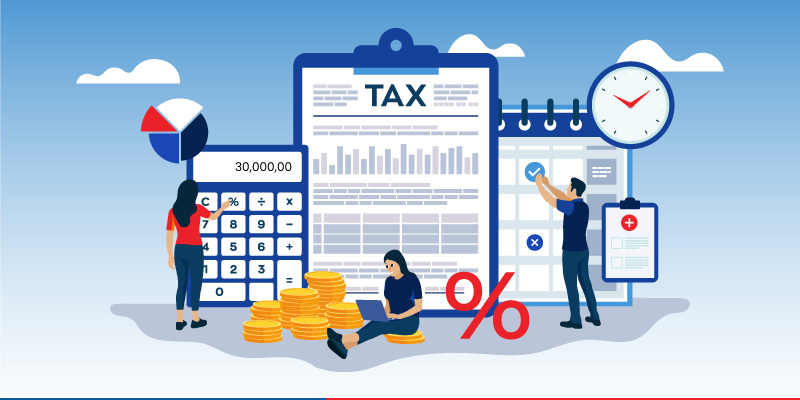What do you want to do?
The Ultimate Guide to the Double Taxation Avoidance Agreement (DTAA)

Table of Content
This article focuses on the DTAA agreement between India and the USA, one of the most significant agreements for NRIs earning across borders. We will break down complex tax concepts into simple, actionable insights for better financial decision-making.
What is DTAA: Understanding the Meaning and Full Form
The Double Taxation Avoidance Agreement (DTAA) is a bilateral treaty between the governments of two countries designed to ensure that income earned in one country is not taxed again in another. Imagine it as a "tax peace treaty" that infuses sense and equity into cross border transactions.
The primary goals of the India-USA DTAA are given below:
To eliminate double taxation
Foster bilateral economic cooperation
Increase transparency in tax matters
Avoid tax evasion with the help of information exchange
Have clear tax regulations for individuals and companies with international operations
For example, without a DTAA, an NRI earning a salary in the U.S. and filing taxes there may also be taxed again in India on the same income, resulting in financial strain.
Through the double taxation avoidance agreement between India and the USA, relief measures in taxation, such as exemption or tax credit, prevent you from paying the same income twice in taxes, simplifying and making financial planning more predictable.
How Does a DTAA Work?
The double taxation avoidance agreement between India and the USA primarily achieves its objectives through two methods of relief: the Exemption Method and the Tax Credit Method. This helps taxpayers to avoid the disadvantage of double taxation by paying tax on the same income in both nations.
Here is a detailed explanation of both these methods:
Exemption Method
Under this method, income is taxed in only source country and exempted in the country in which the person is resident. For example, if you receive a salary in the US and the treaty allows for exemption, India will not tax that very same salary under Exemption method. This is especially useful for salary income received overseas, as it avoids dual taxation on the exact source of income and eases tax compliance.
Tax Credit Approach
Under the Tax Credit Approach, the income is taxable in both nations. It entitles taxpayers to offset tax paid in one nation against tax payable in the other through a direct relief mechanism, such as a credit.
For instance, consider Rahul, an Indian software engineer employed in the US, earning $100,000. He has to pay $25,000 in US tax. Without a DTAA, if India levies a 30% tax, Rahul will have to pay ₹ 22, 50,000 (30% of ₹ 75, 00,000) extra in India.
However, with the DTAA agreement between India and the USA, Rahul can take credit for the payment of taxes in the US. His Indian tax liability will decrease significantly without double taxation. Hence, this framework makes DTAA an essential instrument of financial planning for NRIs and professionals working across borders.
India and USA DTAA: A Detailed Look for NRIs
The India–USA DTAA establishes clear regulations for taxation of different types of income to help NRIs get lower tax rates and escape double taxation. Here are the specific provisions affecting different income types:
Salary Income
According to the double taxation avoidance agreement between India and the USA, the place of employment usually possesses the first right of taxation. For example, if a citizen of India works in the US, income from salary is mostly taxed in the US.
Additionally, India can tax it if the individual is considered a resident of India. However, relief under DTAA avoids double taxation through credit or exemption options.
Dividends
DTAA offers concessional tax rates on dividends (not being covered under section 115-O). Under Article 10 of India-USA DTAA, dividend paid by US Company to an Indian Resident can be taxed in India. Further, the US also retains the right to tax such dividend income, but the tax charged should not exceed:
15% of the gross amount of dividend if the beneficial owner holds 10% or more of the voting stock,
25% of the gross amount of dividend in all other case.
This favourably impacts NRIs receiving dividend income from US firms, relief from double taxation can be claimed under Section 90 and 91of the Income Tax Act, 1961 read with the DTAA.
Interest Income
Under Article 11 of India-USA DTAA, interest paid by US Company to an Indian Resident can be taxed in India. Further, the US also retains the right to tax such interest income, but the tax charged should not exceed:
10% tax rate of the gross amount in case of Interest on Bank loans or by a similar financial institution (including Insurance companies).
15% tax rate of the gross amount in other cases , for instance, from bonds or debentures,
These are concessional rates and promote cross-border borrowing and investment.
In India, as per the Income-tax Act, 1961, interest income payable to a non-resident is generally taxable under Section 115A at on the gross amount. However, where the DTAA provisions are more beneficial, the taxpayer can opt for the lower concessional rate under Section 90 of the Income Tax Act, 1961.
Capital Gains
For real estate, the country in which the property is located enjoys first-right taxation. Gains on shares and securities are mainly taxable in the home country, minimising tax disputes for investors.
Annuities from Insurance Companies
Under Article 20 of the USA-India DTAA, annuities derived by a resident of one Contracting State i.e. USA from the Insurance Company of the other Contracting State i.e. India are taxable only in the First-Mentioned Contracting State. This ensures that double taxation does not arise in both countries. For example, if a US resident gets regular annuity payments from an insurance company in India, those payments will be taxable only in the USA, his country of residence.
In India, annuities received from insurance companies are generally taxable under the head “Income from Other Sources” or “Salaries” depending upon the nature of the annuity contract. However, where the DTAA provisions are more beneficial, a resident may claim relief under Section 90 of the Income-tax Act, 1961, ensuring that such annuity income is taxed only in the State of residence as provided by Article 20.
Income Type |
Maximum Tax Rate as per India-USA DTAA |
Conditions |
Dividends |
15% |
For beneficial owners with ≥10% voting stock |
Dividends (Others) |
25% |
For all other cases |
Bank Loan Interest |
10% |
For specified banking loans |
Other Interest |
15% |
For non-banking interest income |
Annuity |
Tax-free in India for USA Residents |
For Annuities from Insurance Companies |
Key Provisions for claiming benefits under the India-USA DTAA
The double taxation avoidance agreement between India and the USA prescribes detailed compliance procedures to enable NRIs to seek relief from tax and double taxation successfully. Here is the breakdown of more specific key provisions of this treaty:
Documentation Requirements
The crucial document is the Tax Residency Certificate (TRC), which acts as a confirmation of the taxpayer’s residency status in the foreign country. Furthermore, the TRC must contain the taxpayer's name, nationality, tax identification number (TIN Number), address abroad, and a certification of the period of residence. This confirms that both tax authorities can accurately determine tax eligibility.
Form 10F Requirements
If the TRC lacks all the necessary information, the Form 10F becomes obligatory. It should be filed electronically on the Income Tax Portal and supported by documents such as proof of residence and TIN to reflect foreign residency information accurately.
Compliance Process
NRIs who enjoy the benefits of the DTAA agreement between India and the USA must comply with annual filing requirements. They need to file Schedule FSI (Foreign Source of Income) and Schedule TR (Tax Relief) along with income tax returns. Moreover, Form 67 must be filed to claim the foreign tax credit against Indian tax.
All these provisions together help NRIs enjoy a transparent and formal process while availing themselves of the benefits of DTAA, minimising the chances of mistakes and maximising tax relief.
The Broader Context of DTAA
Although the India–USA DTAA is one of the most important for NRIs, India has entered into similar pacts with more than 90 countries including UK, Germany, Singapore, Australia, and Canada, creating a vast worldwide network of tax treaties. These treaties enhance cross-border trade, investments, and financial security for individuals and enterprises working globally.
The significant advantages of India's DTAA network are:
Avoidance of double taxation on income received abroad.
Encouragement of cross-border investments due to lower withholding tax rates.
Coherent system of tax liabilities across jurisdictions.
Streamlined procedure for tax credits, ease of compliance for taxpayers.
International tax treaties safeguard against discriminatory tax practices.
This network provides individuals and businesses with the assurance of applying identical tax principles and lower administrative barriers in many countries.
Conclusion
The double taxation avoidance agreement between India and the USA is an essential tool for NRIs, preventing double taxation on the same income and ensuring maximum financial efficiency. Well-prompt implementation of DTAA provisions provides substantial cost savings and increased tax clarity across borders.
Tax laws and treaty provisions are subject to frequent changes. Therefore, staying updated about these changes is essential for individuals who have income in both countries. Moreover, hiring a professional tax advisor ensures proper compliance, on-time filing, and maximises the use of all applicable tax credits. For NRIs navigating international income intricacies, a thorough understanding and effective implementation of DTAA rules are crucial for more secure financial planning.
Understanding how DTAA laws can be applied to avoid double taxation on particular financial products, such as life insurance, where a maturity payout might be subject to taxation in one nation but qualify for a tax credit in another, is part of this.
Are you an NRI looking for the best way to secure your family's future? Explore our life insurance plans designed to meet the unique needs of non-resident Indians.
FAQs on Double Taxation Avoidance Agreement (DTAA)
What are the incomes on which an NRI can claim tax credit/tax exemption for income earned in India in the resident country?
Which method is used to avoid double taxation?
Are there any conditions to benefit from DTAA?
Who benefits from DTAA?
NRIs can claim tax relief on salary, dividends, interest, royalties, capital gains, and business profits earned in India, as provided in the DTAA between India and USA on compliance of the prescribed procedure.
The double taxation avoidance agreement between India and the USA uses both the Exemption Method (income taxed only in one country) and the Tax Credit Method (foreign tax paid is deducted from domestic tax liability), depending on the type of income and treaty provisions.
Yes, NRIs must provide a Tax Residency Certificate (TRC), submit Form 10F when required, and file tax returns with Schedule FSI, Schedule TR, and Form 67 to claim foreign tax credits or exemptions correctly under DTAA provisions.
NRIs, foreign investors, multinational companies, and cross-border professionals benefit from DTAA, as it prevents double taxation, promotes international trade and investment, reduces tax burdens, and offers clear compliance rules for incomes earned across different jurisdictions worldwide.
Related Articles
- Life Insurance for NRI
- Term Insurance For NRI
- NRI taxation
- NRI Investment Plans
- ULIP Plans for NRIs
- Pension Plan for NRI

Not sure which insurance to buy?
Talk to an
Advisor right away
Advisor right away

We help you to choose best insurance plan based on your needs
Here's all you should know about life insurance.
We help you to make informed insurance decisions for a lifetime.
HDFC Life
Reviewed by Life Insurance Experts
HDFC LIFE IS A TRUSTED LIFE INSURANCE PARTNER
We at HDFC Life are committed to offer innovative products and services that enable individuals live a ‘Life of Pride’. For over two decades we have been providing life insurance plans - protection, pension, savings, investment, annuity and health.

Popular Searches
- Term Insurance Calculator
- Investment Plans
- Investment Calculator
- Investment for Beginners
- Best Short Term Investments
- Best Long Term Investments
- 5 year Investment Plan
- savings plan
- ulip plan
- retirement plans
- health plans
- child insurance plans
- group insurance plans
- income tax calculator
- bmi calculator
- compound interest calculator
- income tax slab
- Income Tax Return
- what is term insurance
- Ulip vs SIP
- tax planning for salaried employees
- HRA Calculator
- Annuity From NPS
- Retirement Calculator
- Pension Calculator
- nps vs ppf
- short term investment plans
- safest investment options
- one time investment plans
- types of investments
- best investment options
- best investment options in India
- Term Insurance for Housewife
- Money Back Policy
- 1 Crore Term Insurance
- life Insurance policy
- NPS Calculator
- Savings Calculator
- life Insurance
- Gratuity Calculator
- Zero Cost Term Insurance
- critical illness insurance
- itc claim
- deductions under 80C
- section 80d
- Whole Life Insurance
- benefits of term insurance
- types of life insurance
- types of term insurance
- Benefits of Life Insurance
- Endowment Policy
- Term Insurance for NRI
- Term Insurance for Women
- Term Insurance for Self Employed
- Benefits of Health Insurance
- Health Insurance for Senior Citizens
- Health Insurance for NRI
1. Provided all due premiums have been paid and the policy is in force.
15. Save 46,800 on taxes if the insurance premium amount is Rs.1.5 lakh per annum and you are a Regular Individual, Fall under 30% income tax slab having taxable income less than Rs. 50 lakh and Opt for Old tax regime.
#Tax benefits & exemptions are subject to the conditions of the Income Tax Act, 1961 and its provisions.
#Tax Laws are subject to change from time to time.
#Customer is requested to seek tax advice from his Chartered Accountant or personal tax advisor with respect to his personal tax liabilities under the Income-tax law.
^ https://indianexpress.com/article/trending/top-10-listing/top-10-countries-with-the-largest-indian-diaspora-2024-9727289/
ARN - ED/09/25/27098


